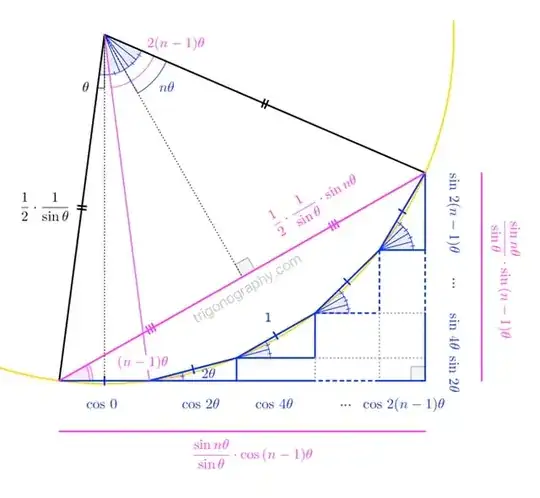I did this by using $\Large{\frac{e^{i\theta}+e^{-i\theta}}{2}}$ formula to their corresponding cos terms
L.H.S
=$\Large{cos{(\theta)}+cos{(\theta+\alpha)}+......+cos(\theta+n\alpha)}$
=$\Large{\frac{e^{i\theta}}{2}(1+e^{i\alpha}+e^{i2\alpha}+......+e^{in\alpha})+\frac{e^{-i\theta}}{2}(1+e^{-i\alpha}+e^{-i2\alpha}+......+e^{-in\alpha})}$
using geometric progression formula
=$\Large{\frac{e^{i\theta}}{2}(\frac{e^{i\alpha(n+1)}-1}{e^{i\alpha}-1})+\frac{e^{i\theta}}{2}(\frac{1-e^{-i\alpha(n+1)}}{1-e^{-i\alpha}})}$
=$\Large{\frac{e^{i\theta}}{2}(\frac{e^{i\alpha(n+1)}-1}{e^{i\alpha}-1})+\frac{1}{2e^{(\theta+n\alpha)}}(\frac{e^{i\alpha(n+1)}-1}{e^{i\alpha}-1})}$
=$\Large{(\frac{e^{i\alpha(n+1)}-1}{e^{i\alpha}-1})(\frac{e^{i(2\theta+n\alpha)}+1}{2e^{i(\theta+n\alpha)}})}$ ........(1)
Now $\Large{(\frac{e^{i\alpha(n+1)}-1}{e^{i\alpha}-1})*\frac{(e^{-i\alpha}-1)}{(e^{-i\alpha}-1)}}$
=$\Large{\frac{e^{i\alpha n}-e^{-i\alpha}+1-e^{-i\alpha(n+1)}}{2-2cos(\alpha)}}$
and $\Large{(\frac{e^{i(2\theta+n\alpha)}+1}{2e^{i(\theta+n\alpha)}})*\frac{(2e^{-i(\theta+n\alpha)})}{(2e^{-i(\theta+n\alpha)})}}$
=$\Large{\frac{e^{i\theta}+e^{-i(\theta+\alpha n)}}{2}}$
So from (1)
$\Large{(\frac{e^{i\alpha n}-e^{-i\alpha}+1-e^{-i\alpha(n+1)}}{2-2cos(\alpha)})}*\Large{(\frac{e^{i\theta}+e^{-i(\theta+\alpha n)}}{2})}$
=$\Large{\frac{e^{i(\alpha n + \theta)}-e^{-i(\alpha n + \theta)}-e^{i(\theta-\alpha)}-e^{-i(\theta-\alpha)}+e^{i\theta}+e^{-i\theta}-e^{i(\theta+\alpha(n+1))}-e^{-i(\theta+\alpha(n+1))}}{4(1-cos(\alpha))}}$
=$\Large{\frac{cos(\alpha n+\theta)-cos(\theta-\alpha)+cos(\theta)-cos(\theta+\alpha(n+1))}{2(1-cos(\alpha))}}$ ..........(2)
Now
$cos(\theta)-cos(\theta-\alpha)=2sin(\frac{\alpha}{2}-\theta)(sin(\frac{\alpha}{2}))$
and
$cos(\alpha n+\theta)-cos(\theta+\alpha(n+1))=2sin(\frac{2\alpha n +\alpha+2\theta}{2})(sin(\frac{\alpha}{2}))$
also $(1-cos(\frac{\alpha}{2})=2sin^{2}(\frac{\alpha}{2}))$
from (2)
$\Large{\frac{sin(\frac{\alpha}{2}-\theta)+sin(\theta+\alpha n+\frac{\alpha}{2})}{2sin(\frac{\alpha}{2})}}$
=$\Large{\frac{sin(\frac{\alpha(n+1)}{2})cos(\theta+\frac{\alpha n}{2})}{sin(\frac{\alpha}{2})}}$
The sine series can also be done in this way
